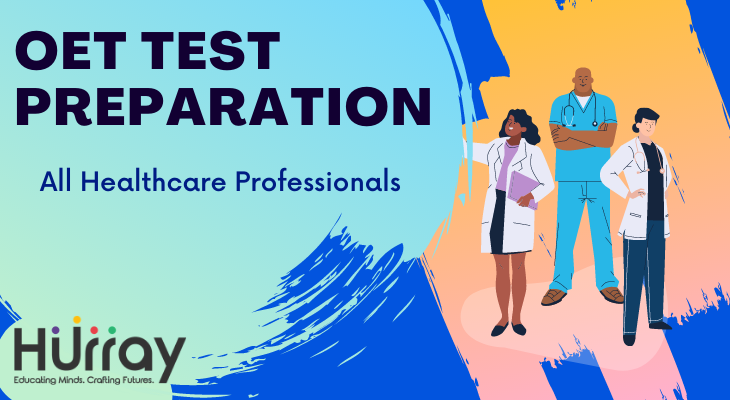Let me take you through the format of OET 2.0 followed by a few tips and strategies to help you prepare for the exam.
Occupational English Training or OET opted by specialized professionals like nurses, doctors, and pharmacists, is also an English language proficiency test like the IELTS, TOEFL, and PTE, but is opted by specific professionals. It emphasizes communication in healthcare professional settings and provides a valid and reliable assessment of all four language skills – listening, speaking, reading, and writing.
OET Listening Module
The test is not profession-specific and unlike the writing and speaking tests, this test is designed to test your ability to process information in English via Listening, in general, healthcare environments/situations.
There are 3 parts to the test with a total of 42 questions. For all 3 parts together, the total time limit is 50 minutes.
You can watch the video here for more information on OET Listening
OET Reading Module
Find everything you need to know about OET Reading in one place!
Format of the Test
OET Reading is the same for all health professions. It’s the 2nd test of the day, to be completed in 60 minutes.
The test is divided into 3 parts – A, B, and C. Each part has a different testing focus. Each question has equal weightage, adding up to a maximum score of 42.
|
Part A |
Part B |
Part C |
|
Consists of 4 short texts and 20 questions (including matching, gap-fill, short answers). |
Consists of 6 short texts of 100-150 words each, and 6 multiple-choice questions (1 per text). |
Consists of 2 long texts of 750-850 words each, and 16 multiple-choice questions (8 per text). |
|
Complete in 15 minutes. |
45 minutes for Part B and C, taken together. |
|
|
Type of Texts: workplace texts - treatment protocols, medication info, treatment parts, diagnosis tools |
Type of Texts: workplace communication between colleagues - updates, policy documents, memos/emails, guidelines |
Type of Texts: Long articles on general healthcare topics |
|
Testing Focus: skimming and scanning texts in English |
Testing Focus: reading for gist, purpose, main points, and detail |
Testing Focus: reading for inference, attitude, and opinion |
Tips for OET Reading Preparation
Part A
-
Practice reading for details: Read similar texts from your own workplace.
-
Increase the amount of English you are skimming and scanning: Set device controls to English, read timetables and menus in English, and use an English-to-English dictionary while studying.
-
Play word searches to improve scanning skills: Train your brain to scan all over the text, instead of only from start to finish, in order. Notice what makes some words different from others – like unusual letters e.g. x, z, double letters e.g. ss, pp, unusual letter combinations e.g. ph, ua. When you learn to scan for these features, you train your eyes to find words more quickly.
-
Practice tests: Read questions carefully – one part of the question provides you with the type of information you need to look for, while another part provides useful details to help locate that information.
Part B
-
Practice reading for the main idea in English: Read similar texts at your own workplace. You can also read online articles, and the type of pamphlets you would find in clinic waiting rooms.
-
Practice reading for gist: Read section by section. Pause after each to decide the main point.
-
Practice tests: For each question, a context statement is provided at the start to give you its purpose. Read the answer options carefully – pay attention to the differences between the options, to identify the correct answer. Read all the texts carefully to check whether an option is correct or incorrect – notice evidence that proves other options wrong e.g. things not mentioned or mentioned differently.
Part C
-
Practice reading for the writer’s perspective in English: Read texts that are opinionated rather than factual, such as journals from your professional regulatory body, or review articles on recent research papers.
-
Practice reading long texts: You must train your brain to concentrate for longer, and develop strategies to deal with unfamiliar words. Avoid using a dictionary; instead, underline the word, guess its meaning, and check at the end if you are correct. Record useful words in a vocabulary notebook, and aim to learn 6-8 per day.
-
Practice tests: While reading the text and answer options, you won’t need to know the definition of each word, but must be able to understand the meaning of the words in a sentence.
How to Handle OET Reading Test-Day?
Use these strategies to tackle each part of OET Reading.Part A
-
Glance at all 4 texts at the start to understand the topics.
-
Complete the sections in order.
-
Copy answers accurately. You can use the words directly from the text. You’ll be penalised for spelling mistakes.
-
Manage your time well. Don’t be too worried about time. If a question is hard, skip it for now and return to it later.
Part B
-
Understand the type and purpose of each text.
-
Read the answer options carefully.
-
Check the texts carefully for the answers. You need to find evidence for why an option is correct.
-
Manage your time well. Leave about 35 mins for part C.
Part C
-
Progress through the texts from start to finish, and answer questions in order. Read them carefully.
-
Approach each question individually, not in relation to the others.
-
Manage your time well. You make sure you have enough time for each text, as well as to return to unanswered questions at the end.
Watch this video for more tips on OET Reading
OET Writing Module
Find general information and tips for the OET Writing Module, here.Format of OET Writing Test
OET Writing is profession-specific, though the format remains the same. It is the 3rd module on test day. The test consists of a formal letter on a medical matter. It is usually a referral letter, though others may be given.
You’ll be given case notes, which describe the patient and the medical condition. In the end, the main ‘writing task’ will be mentioned. You’ll have 5 mins to read, and 40 mins to write your response.
You’ll be graded by 2 independent assessors.
OET Writing Assessment Criteria
Each criterion is weighted equally. You’ll be assessed out of 5 marks.
-
Overall task fulfilment: Impact on the reader, including length
-
Appropriateness of language: Formality and organisation
-
Comprehension of stimulus: Selection of relevant case notes
-
Control of linguistic features: Appropriate grammar and logical structure
-
Control of presentation features: Spelling, punctuation, and layout
Tips for OET Writing Preparation
1. Focus on the reader
The letter could be about any patient and healthcare situation – such as an emergency situation, writing to someone who is not a healthcare professional e.g. social worker, an allied health professional or specialist e.g. palliative caregiver, or to a fellow professional already involved in the case.
Keep the imaginary reader in mind, and think about the letter from their perspective. Personalise the letter accordingly. Avoid using a single, learned template.
Use the case notes to make choices about what and how to write:
-
Remember, the case notes are only a prompt – what you choose to include is up to you, and you’ll be graded accordingly.
-
Read the ‘Writing task’ at the end of case notes first – this contains the most important information i.e. who you are writing to and why.
-
Ask yourself, what will the reader need to know, and what they already know. Accordingly, select information from the case notes.
-
Identify the level of importance of the information, as you read – A is essential information, B is secondary, but still useful information, and C is unimportant. Later when you write, list this information in order of importance.
2. Use the Right Language
These are some useful grammar elements that’ll help you write your letter.
-
Use passive forms: This will make the patient and relevant information like treatment the focus of the sentence while excluding unnecessary information.
e.g. If you write “I arranged a blood test for Mr. X”, you’re including irrelevant information about who ordered the test. Instead, write “A blood test for Mr. X has been arranged.”
-
Use correct verb tense: Using the correct past, present, or future tense is very important so that the reader gets your intended meaning. This is especially the case when writing about a patient’s present or past condition, future treatment, etc.
3. Practice
-
Variety of healthcare situations and types of patients.
-
Writing in test conditions. Give yourself a strict time limit of 40 minutes. Try to use the same stationery you’ll use on test day.
-
Get feedback from someone trained.
-
Make a checklist of your common mistakes to refer to later.
-
Read official sample answers, which can demonstrate letter layouts, natural language, and an example structure. However, don’t learn them as templates to be copied in the test.
How to Handle OET Writing Test-Day?
1. During Reading Time
-
Read the ‘writing task’ first, to find out about the reader and the purpose of the letter.
-
Read the case notes slowly. At the end of each point, pause and ask yourself, “does the reader need to know this” – if not, mark it with an ‘x’ to omit. If yes, decide how important it is on the ABC scale.
-
Once you finish reading the case notes, think about the reader again and how you will explain the relevant information to them.
2. During Writing Time
-
Consider spending the first few minutes planning. Plan your overall structure and the topic of each paragraph.
-
If you make a mistake, cross it out and carry on.
-
Give your letter a proper ending. If the time limit is approaching, leave space where you are, write the ending, and then return to complete the letter.
-
Allow time to proofread your letter. Put yourself in your reader’s shoes again – ask, do they have enough info? Besides that, check for the mistakes you typically make.
-
Don’t worry about the word limit. If you have selected only the relevant information, your letter will be of the appropriate length.
If you are a physiotherapist, read our blog on writing tips for physiotherapists.
Watch this video to know more about OET Writing Sub-Test
OET Speaking Module
A one-stop guide for everything on OET Speaking!Format of OET Speaking Test
OET Speaking is profession-specific, though the format remains the same. It is the final module on test day.
Section 1: Warm-up
This part of the test is not assessed. It is meant for you to become familiar with the interlocuter’s voice and try to relax. They will ask general questions.
Section 2: Role-play
You’ll get 2 role-plays. You’ll have 3 minutes to prep and 5 minutes to speak in each. You’ll be given a role card containing instructions and information. The interlocuter plays the patient, while you play the healthcare professional.
You’ll be graded by 2 independent assessors. Borderline differences are assessed by a 3rd assessor so that you get a fair and valid grade.
Assessment of OET Speaking
Each role-play is assessed against:
I) Linguistic Criteria – scored out of 6
- Intelligibility: Pronunciation, intonation, and accent
- Fluency: Speed and smoothness of your speech
- Appropriateness: Language, tone, and professionalism
- Resources of grammar and expression: Grammatical accuracy and vocabulary choices
II) Communication Criteria – scored out of 3
- Relationship-building: Choice of opening to the conversation, demonstration of empathy and respect
- Understanding and incorporating the patient’s perspective
- Providing structure: How you organise the information you provide, how you introduce new topics for discussion
- Information-gathering: Type of questions you ask, how you respond to the listener
- Information-giving: Type of information you give, language you use
Tips for OET Speaking Preparation
I) Focus on the listener
Each role-play involves a different patient and healthcare situation, which means you must personalise communication. Avoid using learned phrases.
Use the role-card to make communication choices:- Check the setting – where is the conversation taking place, is it an emergency situation or not. This will help you decide how to start speaking.
- Check the condition and purpose of the role-play – this will tell you what you do and don’t know so that you can accordingly get more information from the patient.
- Check your tasks i.e. points to cover – you may not be able to complete all, but you must try to cover as many as possible.
II) Imagine a Real Patient
Imagine that the interlocuter is a real patient.
- Decide your communication based on the type of patient – a patient in an emergency situation, one with pre-existing knowledge about their condition, an older or younger patient, or a very emotional one, such as a frustrated or anxious patient.
- Sometimes, the interlocuter may not play a patient, but a patient’s family member or caregiver.
- In the role card, adjectives can indicate how the patient is feeling. This will help you make choices about how to start speaking, and what info to provide.
- Put yourself in the patient’s shoes, and ask yourself what would they want to hear. This may differ from what you would think they need to know.
- Be reassuring.
III) Structure Your Communication
These are the stages of good communication:
- Understand your patient’s perspective.
- Validate their perspective, using empathy.
- Explain information clearly and simply. Provide information that they need. Avoid unnecessary medical language, unless they already have pre-existing knowledge.
- Check if your patient has understood. Ask them if they have questions or need clarifications.
There are also stages of listening, that are important to good communication:
- Encourage your patient to talk freely, and later, encourage them to continue by saying ‘right’, ‘okay’ when they pause.
- Avoid interrupting your patient.
- Provide an appropriate response to show that you were listening – you can summarise what the patient has said, or ask follow-up questions.
IV) Practice
- Variety of healthcare situations and types of patients.
- Record yourself, so you can assess yourself later.
- Get feedback from someone trained.
- Make a record of useful phrases, usable in a number of situations, and practice using them.
In the video below, the expert talks about how you can ace the OET Speaking test
How to Handle OET Speaking Test-Day?
I) During Preparation Time:
Ask the interlocuter any questions you may have, or to define or pronounce unfamiliar words.
Plan how much time you’ll take on each task so that you can cover as much as possible.
Think about how the patient feels, and decide what language to use.
Decide how you’ll start, so that you’re ready when the interlocutor tells you to start.
II) During Role-Play
Keep talking during the 5 mins. The interlocuter will tell you when to stop.
Balance the time you spend speaking and listening.
It’s okay if the patient doesn’t understand something, as the interlocutor doesn’t have medical knowledge. Simply ask how you can clarify.
Remember, OET is not testing your medical knowledge, only language.
Did you find this information on OET Listening, Writing, Reading, and Speaking module useful? You can watch more videos on OET by subscribing to Hurray’s YouTube Channel.
To know more about it join OET Online Training or OET Classroom Training at Hurray. Reach out to us at info@hurrayedutech.com or call us at 9900426501.
Hurray offers Study Abroad consultation, IELTS/PTE/OET, and Spoken English programs. Visit our website https://www.hurrayedutech.com/ for more information.











Post Comments